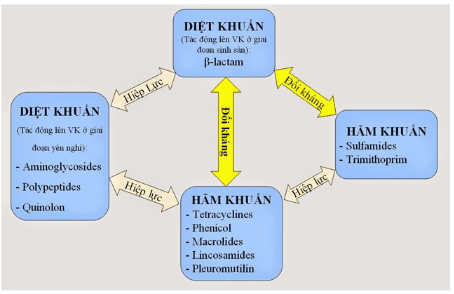This is an automatically translated article.
Each antibiotic has certain advantages and disadvantages. When antibiotics are used in combination, these side effects can add up or increase. Therefore, the combination of antibiotics in treatment should also adhere to the principles of reasonable antibiotic combination.
1.The role of antibiotic combination in treatment
In some specific cases, the combination of antibiotics can bring certain advantages such as reducing the possibility of resistant strains, treating infections caused by many types of bacteria at the same time. increased bactericidal capacity. However, antibiotics should only be combined with absolutely necessary cases as follows:The patient is infected with 1 or more bacteria at the same time. Patients are infected with specific strains of bacteria that need a new antibiotic combination for good effect. Patients with tuberculosis, leprosy, endocarditis, Brucellosis... Patients with severe infections of unknown cause or unable to wait for test results. SEE ALSO: Classification and mechanism of action of antibiotics

Bệnh nhân bị bệnh lao có thể phối hợp kháng sinh
2.Classification of antibiotic group
In order to choose and use the right antibiotic, the doctor needs to make an accurate clinical diagnosis, based on the microbiological results and perform an antibiogram. However, in case of urgent need for treatment before the experimental results are available, it is necessary to rely on experience and understanding of antibiotics to choose appropriate and effective antibiotics. Basically, there are antibiotic groups as follows:β-lactams: Penicillins; Cephalosporins, Ampicillin; Amoxicillin; Aminoglycoside group : Streptomycin; Kanamycin; Gentamycin Polypeptide group : Colistin Macrolide group : Tylosin; Spiramycin; Rifampicin Pleuromutilin group: Tiamulin Lincosamide group : Lincomycin; Tetracycline group: Tetracycline; Oxytetracycline; Doxycycline; Clotetracycline. Phenicol group : Chloramphenicol; Thiamphenicol; Florfenicol Quinolone group : Nalidixic acid, Norfloxacin; Fluoroquinolones; Enrofloxacin Sulfonamide group : Sulfaguanidin, Sulfadiazine... Diaminopyrimidine group : Trimethoprim MORE: Antibiotics and bacteria: What you need to know
3. Antibiotic combination chart
Each antibiotic has certain advantages and disadvantages. When antibiotics are combined in treatment, these side effects can also add up or increase. Therefore, the combination of antibiotics also needs to comply with the principles of reasonable antibiotic combination.
3.1. The case of synergistic combination of antibiotics The synergistic effect of antibiotic combination can be explained by:
Expanding the spectrum of action. Enhanced antibacterial effect by inhibiting multiple bacterial life processes at the same time. Antibiotics of one type create conditions for other antibiotics to exert their pharmacological effects. Typical of a synergistic relationship:
β-lactams and aminoglycosides : eg Penicillin and Streptomycin ; Amoxicillin and Gentamycin ; Penicillin and Gentamicin .... β-lactam group and group of Polypeptides: eg Amoxicillin and Colistin ; Ampicillin and Colistin... Tetracyclines group and Macrolides group: eg Doxycycline and Tylosin... β-lactam group and Metronidazol are combined in the treatment of peritonitis, lung abscess, brain abscess, some gynecological infections ...Each antibiotic kills one type of bacteria, and a combination of the two kills more bacteria. However, not every patient using together two antibiotics with a synergistic mechanism will enhance the best antibacterial effect. The combination of antibiotics, in addition to the principle of synergies, also needs to be consistent with the pharmacokinetic phases of each drug as well as the location of the pathogen in the body. Self-administration of each antibiotic alone and in combination is not easy.

Nhóm β-lactam và Metronidazol được phối hợp trong điều trị viêm phúc mạc
3.2. Cases of antagonism when combining antibiotics Cases of wrong drug combination will reduce the pharmacodynamics of the drug, the consequences of combining 2 drugs but the effect is not equal to using 1 drug. Some combinations inevitably cause antagonism:
Combination of bacteriostatic antibiotics with bactericidal antibiotics: For example, Penicillin and Tetracycline; Combination of antibiotics with the same mechanism of action or toxicity on the same organ. For example, combining 2 antibiotics in the same group will cause liver failure, pancreatic failure while the effectiveness of treatment will not increase. Combination of antibiotics induces resistance. For example: Cefoxitin and Penicillin... MORE: Why is it important to treat staphylococcal diseases based on the results of the antibiogram?
4.Difficulty in antibiotic combination
In addition to the basic principles, the combination of antibiotics is also based on many bases such as:Mechanism of action of antibiotics. Pharmacokinetics, physicochemical properties of antibiotics. Pathogenic bacteria. Disease condition. Other factors...

Khi phối hợp kháng sinh cần dựa trên nhiều yếu tố như loại vi khuẩn gây bệnh của bạn
The combination of antibiotics creates peace of mind and is no longer actively searching for the root cause of the disease. Combinations of antibiotics that require more antibiotics can cause adverse interactions or increase drug toxicity. Treatment costs increase but sometimes treatment results do not increase. In summary, the combination of antibiotics should only be done when absolutely necessary and in accordance with the antibiotic combination scheme, the right dose, the right dose interval and the prescribed time to limit the risk of antibiotic resistance in patients. patient. The indiscriminate use of antibiotics can leave many health consequences, so when there is a disease, patients should choose a reputable medical facility to perform the appropriate examination and prescription.
At Vinmec International General Hospital, the entire examination and prescription process is weighed between the benefits and side effects for the patient when using the drug. Accordingly, the close coordination of doctors and clinical pharmacists will make reasonable antibiotic use options, based on the antibiotic combination scheme, ensuring effective treatment and minimizing side effects. drugs, reducing the risk of antibiotic resistance.
Please dial HOTLINE for more information or register for an appointment HERE. Download MyVinmec app to make appointments faster and to manage your bookings easily.













